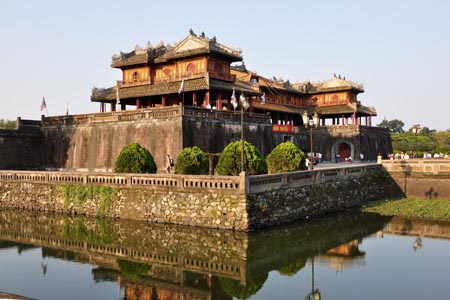Hue has a reputation for a number of historical sites packed with thousands of years of history under the rule of many dynasties. To get the full taste of ancient Hue, Hue Imperial Citadel is a must. The place is not only an attractive tourist destination but also a living edition witnessing dramatic changes of Vietnam’s history. Therefore, do not hesitate to plan a trip to this awesome place to obtain ultimate experience.
An overview
Under Nguyen Lord’s Dynasty, the charming and poetic Hue was the capital city of the nation. Nestled on the northern bank of Perfume River, it is a giant complex for the residents as well as royal families. The citadel complex is the home to three circles spreading over an area of 520 ha including Hue capital citadel, Royal citadel and Forbidden Purple Citadel.
Characterized as the most impressive structure of all time, Hue imperial citadel encompasses huge workload with a great number of workers. Especially, one striking feature of the complex is the two sand dunes Con Hen and Con Da Vien which are considered the protectors of the citadel. Hue Imperial Citadel today has become a rich source of inspiration for countless artists to depict the truly beauty of Hue, thereby creating valuable and precious artistic works.
Hue Imperial Citadel highlights
Come to explore the amazing interior of the complex, you should make first stoppage at Hue capital citadel – the first circle of the complex. Its construction ranging from 1805 to 1832 is highlighted by a massive structure of a square shape featuring 10 kilometers in circumference, 6 meters high and 21 meters thick. Moreover, you can also catch a glimpse of 24 bastions with a view to defending the citadel.
Continue your exploration by heading to Royal Citadel - the second circle of the Citadel. Built in 1804, the construction of the Royal Citadel took 29 years more or less to be totally completed during the reign of King Ming Mang. One of the most remarkable features is that it was built with bricks and surrounded by a system of trench which serves the function of protecting the citadel, thereby shaping unique and ancient appearance. In addition to its unique construction, the attractiveness of Royal Citadel lies in its broad collection of approximately 100 wonderful architectural works. Therefore, do not miss the chance to explore those amazing things that Royal Citadel offers.
After exploring Royal Citadel, stop at Forbidden Citadel to enjoy the sense of Vietnam’s former imperial capital. The Purple Forbidden Citadel was used by Emperor and his Royal families. The place is the home to around 50 constructions with amazing architectural styles and 7 gates. A trip to explore the Purple Forbidden Citadel will give you a deeper insight into Dai Cung Mon, also known as the Great Palace Gate served for Kings, Can Chanh Palace which was the work place of Emperors, Can Thanh also known as Emperor’s Private Palace and other places including Khon Thai Residence, Duyet Thi Duong house, Thai Binh Lau and Thuong Thien.
Those sites are such great and ideal places for tourists to gain a first-hand experience of architectural values of myriad feudal relics to have a deeper understanding of Vietnam’s history, culture and tradition and thus sense the strong vitality of classical beauty of the nation. For a hassle-free and secure exploration of Vietnam, reputable Vietnam tour operators can provide valuable insights into local practices, ensuring a safe and enjoyable travel experience.



